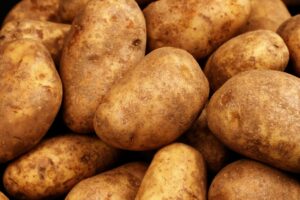Today, I would like to talk about planting your own potatoes, which is a mighty fine idea for several reasons. Firstly, it gives you full control over the quality of the spuds you’re putting on your plate. You can ensure that they’re free from nasty chemicals and pesticides, and you can pick the best variety for keeping over the winter months.
Now, speaking of varieties, if you’re looking for a potato that’s going to last through the winter, you’ll want to go for a high-starch variety like a Russet or a Yukon Gold. These potatoes have a nice firm flesh that’ll hold up to storage, even in the colder temperatures.
When it comes to planting, you’ll want to get started in the early spring, as soon as the soil has warmed up a bit around 50F. You’ll need to make sure your soil is in good shape, so give it a good working over with some organic matter like compost or well-rotted manure. Cut your seed potatoes into chunks, making sure that each piece has a good sprout or two, and plant them about 4 inches deep and 12 inches apart in rows that are about 3 feet apart.
Now, as your potato plants grow, you’ll need to keep an eye on them and make sure they’re getting enough water. You’ll also want to “hill” them, which means mounding soil up around the stems. This will help to keep the developing spuds covered and protected.
When it comes to storage, you’ll want to cure your potatoes for a week or two after harvest by leaving them in a warm, dry place with good ventilation. After curing, store your potatoes in a cool, dark place with good air circulation. A root cellar is ideal, but a cool garage or basement will work too.
Remember, growing potatoes does take some work and attention to detail, but it’s well worth the effort. There’s nothing quite like the taste of fresh, home-grown potatoes on your plate, especially when it’s cold and miserable outside. I am going to pick up my seed potatoes next week.

